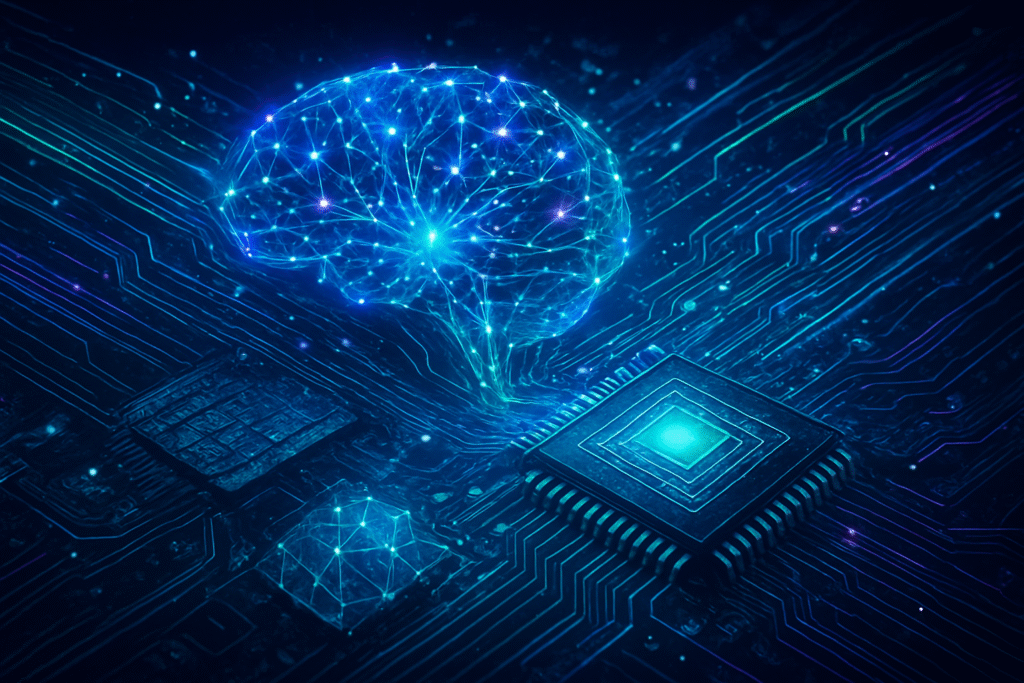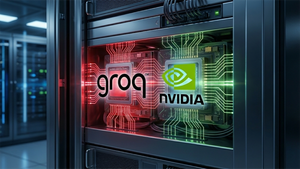
In an era defined by rapid technological advancement, the symbiotic relationship between Artificial Intelligence (AI) and semiconductor development has emerged as the undisputed engine of innovation, propelling both fields into an unprecedented "AI Supercycle." This profound synergy sees AI's insatiable demand for computational power pushing the very limits of chip design and manufacturing, while, in turn, breakthroughs in semiconductor technology unlock ever more sophisticated and capable AI applications. This virtuous cycle is not merely accelerating progress; it is fundamentally reshaping industries, economies, and the very fabric of our digital future, creating a feedback loop where each advancement fuels the next, promising an exponential leap in capabilities.
The immediate significance of this intertwined evolution cannot be overstated. From the massive data centers powering large language models to the tiny edge devices enabling real-time AI on our smartphones and autonomous vehicles, the performance and efficiency of the underlying silicon are paramount. Without increasingly powerful, energy-efficient, and specialized chips, the ambitious goals of modern AI – such as true general intelligence, seamless human-AI interaction, and pervasive intelligent automation – would remain theoretical. Conversely, AI is becoming an indispensable tool in the very creation of these advanced chips, streamlining design, enhancing manufacturing precision, and accelerating R&D, thereby creating a self-sustaining ecosystem of innovation.
The Digital Brain and Its Foundry: A Technical Deep Dive
The technical interplay between AI and semiconductors is multifaceted and deeply integrated. Modern AI, especially deep learning, generative AI, and multimodal models, thrives on massive parallelism and immense data volumes. Training these models involves adjusting billions of parameters through countless calculations, a task for which traditional CPUs, designed for sequential processing, are inherently inefficient. This demand has spurred the development of specialized AI hardware.
Graphics Processing Units (GPUs), initially designed for rendering graphics, proved to be the accidental heroes of early AI, their thousands of parallel cores perfectly suited for the matrix multiplications central to neural networks. Companies like NVIDIA (NASDAQ: NVDA) have become titans by continually innovating their GPU architectures, like the Hopper and Blackwell series, specifically for AI workloads. Beyond GPUs, Application-Specific Integrated Circuits (ASICs) have emerged, custom-built for particular AI tasks. Google's (NASDAQ: GOOGL) Tensor Processing Units (TPUs) are prime examples, featuring systolic array architectures that significantly boost performance and efficiency for TensorFlow operations, reducing memory access bottlenecks. Furthermore, Neural Processing Units (NPUs) are increasingly integrated into consumer devices by companies like Apple (NASDAQ: AAPL), Qualcomm (NASDAQ: QCOM), Intel (NASDAQ: INTC), and AMD (NASDAQ: AMD), enabling efficient, low-power AI inference directly on devices. These specialized chips differ from previous general-purpose processors by optimizing for specific AI operations like matrix multiplication and convolution, often sacrificing general flexibility for peak AI performance and energy efficiency. The AI research community and industry experts widely acknowledge these specialized architectures as critical for scaling AI, with the ongoing quest for higher FLOPS per watt driving continuous innovation in chip design and manufacturing processes, pushing towards smaller process nodes like 3nm and 2nm.
Crucially, AI is not just a consumer of advanced silicon; it is also a powerful co-creator. AI-powered electronic design automation (EDA) tools are revolutionizing chip design. AI algorithms can predict optimal design parameters (power consumption, size, speed), automate complex layout generation, logic synthesis, and verification processes, significantly reducing design cycles and costs. Companies like Synopsys (NASDAQ: SNPS) and Cadence (NASDAQ: CDNS) are at the forefront of integrating AI into their EDA software. In manufacturing, AI platforms enhance efficiency and quality control. Deep learning models power visual inspection systems that detect and classify microscopic defects on wafers with greater accuracy and speed than human inspectors, improving yield. Predictive maintenance, driven by AI, analyzes sensor data to foresee equipment failures, preventing costly downtime in fabrication plants operated by giants like Taiwan Semiconductor Manufacturing Company (TSMC) (NYSE: TSM) and Samsung Electronics (KRX: 005930). AI also optimizes process variables in real-time during fabrication steps like lithography and etching, leading to better consistency and lower error rates. This integration of AI into the very process of chip creation marks a significant departure from traditional, human-intensive design and manufacturing workflows, making the development of increasingly complex chips feasible.
Corporate Colossus and Startup Scramble: The Competitive Landscape
The AI-semiconductor synergy has profound implications for a diverse range of companies, from established tech giants to nimble startups. Semiconductor manufacturers like NVIDIA (NASDAQ: NVDA), AMD (NASDAQ: AMD), and Intel (NASDAQ: INTC) are direct beneficiaries, experiencing unprecedented demand for their AI-optimized processors. NVIDIA, in particular, has cemented its position as the dominant supplier of AI accelerators, with its CUDA platform becoming a de facto standard for deep learning development. Its stock performance reflects the market's recognition of its critical role in the AI revolution. Foundries like TSMC (NYSE: TSM) and Samsung Electronics (KRX: 005930) are also seeing immense benefits, as they are tasked with fabricating these increasingly complex and high-volume AI chips, driving demand for their most advanced process technologies.
Beyond hardware, AI companies and tech giants developing AI models stand to gain immensely from continuous improvements in chip performance. Google (NASDAQ: GOOGL), Meta Platforms (NASDAQ: META), Microsoft (NASDAQ: MSFT), and Amazon (NASDAQ: AMZN) are not only major consumers of AI hardware for their cloud services and internal AI research but also invest heavily in custom AI chips (like Google's TPUs) to gain competitive advantages in training and deploying their vast AI models. For AI labs and startups, access to powerful and cost-effective compute is a critical differentiator. Companies like OpenAI, Anthropic, and various generative AI startups rely heavily on cloud-based GPU clusters to train their groundbreaking models. This creates a competitive dynamic where those with superior access to or design of AI-optimized silicon can achieve faster iteration cycles, develop larger and more capable models, and bring innovative AI products to market more quickly.
The potential for disruption is significant. Companies that fail to adapt to the specialized hardware requirements of modern AI risk falling behind. Traditional CPU-centric computing models are increasingly inadequate for many AI workloads, forcing a shift towards heterogeneous computing architectures. This shift can disrupt existing product lines and necessitate massive investments in new R&D. Market positioning is increasingly defined by a company's ability to either produce leading-edge AI silicon or efficiently leverage it. Strategic advantages are gained by those who can optimize the entire stack, from silicon to software, as demonstrated by NVIDIA's full-stack approach or Google's vertical integration with TPUs. Startups focusing on novel AI hardware architectures or AI-driven chip design tools also represent potential disruptors, challenging the established order with innovative approaches to computational efficiency.
Broader Horizons: Societal Impacts and Future Trajectories
The AI-semiconductor synergy is not just a technical marvel; it holds profound wider significance within the broader AI landscape and for society at large. This relationship is central to the current wave of generative AI, large language models, and advanced machine learning, enabling capabilities that were once confined to science fiction. The ability to process vast datasets and execute billions of operations per second underpins breakthroughs in drug discovery, climate modeling, personalized medicine, and complex scientific simulations. It fits squarely into the trend of pervasive intelligence, where AI is no longer a niche application but an integral part of infrastructure, products, and services across all sectors.
However, this rapid advancement also brings potential concerns. The immense computational power required for training and deploying state-of-the-art AI models translates into significant energy consumption. The environmental footprint of AI data centers is a growing worry, necessitating a relentless focus on energy-efficient chip designs and sustainable data center operations. The cost of developing and accessing cutting-edge AI chips also raises questions about equitable access to AI capabilities, potentially widening the digital divide and concentrating AI power in the hands of a few large corporations or nations. Comparisons to previous AI milestones, such as the rise of expert systems or the Deep Blue victory over Kasparov, highlight a crucial difference: the current wave is driven by scalable, data-intensive, and hardware-accelerated approaches, making its impact far more pervasive and transformative. The ethical implications of ever more powerful AI, from bias in algorithms to job displacement, are magnified by the accelerating pace of hardware development.
The Road Ahead: Anticipating Tomorrow's Silicon and Sentience
Looking to the future, the AI-semiconductor landscape is poised for even more radical transformations. Near-term developments will likely focus on continued scaling of existing architectures, pushing process nodes to 2nm and beyond, and refining advanced packaging technologies like 3D stacking and chiplets to overcome the limitations of Moore's Law. Further specialization of AI accelerators, with more configurable and domain-specific ASICs, is also expected. In the long term, more revolutionary approaches are on the horizon.
One major area of focus is neuromorphic computing, exemplified by Intel's (NASDAQ: INTC) Loihi chips and IBM's (NYSE: IBM) TrueNorth. These chips, inspired by the human brain, aim to achieve unparalleled energy efficiency for AI tasks by mimicking neural networks and synapses directly in hardware. Another frontier is in-memory computing, where processing occurs directly within or very close to memory, drastically reducing the energy and latency associated with data movement—a major bottleneck in current architectures. Optical AI processors, which use photons instead of electrons for computation, promise dramatic reductions in latency and power consumption, processing data at the speed of light for matrix multiplications. Quantum AI chips, while still in early research phases, represent the ultimate long-term goal for certain complex AI problems, offering the potential for exponential speedups in specific algorithms. Challenges remain in materials science, manufacturing precision, and developing new programming paradigms for these novel architectures. Experts predict a continued divergence in chip design, with general-purpose CPUs remaining for broad workloads, while specialized AI accelerators become increasingly ubiquitous, both in data centers and at the very edge of networks. The integration of AI into every stage of chip development, from discovery of new materials to post-silicon validation, is also expected to deepen.
Concluding Thoughts: A Self-Sustaining Engine of Progress
In summary, the synergistic relationship between Artificial Intelligence and semiconductor development is the defining characteristic of the current technological era. AI's ever-growing computational hunger acts as a powerful catalyst for innovation in chip design, pushing the boundaries of performance, efficiency, and specialization. Simultaneously, the resulting advancements in silicon—from high-performance GPUs and custom ASICs to energy-efficient NPUs and nascent neuromorphic architectures—unlock new frontiers for AI, enabling models of unprecedented complexity and capability. This virtuous cycle has transformed the tech industry, benefiting major players like NVIDIA (NASDAQ: NVDA), TSMC (NYSE: TSM), and a host of AI-centric companies, while also posing competitive challenges for those unable to adapt.
The significance of this development in AI history cannot be overstated; it marks a transition from theoretical AI concepts to practical, scalable, and pervasive intelligence. It underpins the generative AI revolution and will continue to drive breakthroughs across scientific, industrial, and consumer applications. As we move forward, watching for continued advancements in process technology, the maturation of neuromorphic and optical computing, and the increasing role of AI in designing its own hardware will be crucial. The long-term impact promises a world where intelligent systems are seamlessly integrated into every aspect of life, driven by the relentless, self-sustaining innovation of silicon and algorithms.
This content is intended for informational purposes only and represents analysis of current AI developments.
TokenRing AI delivers enterprise-grade solutions for multi-agent AI workflow orchestration, AI-powered development tools, and seamless remote collaboration platforms.
For more information, visit https://www.tokenring.ai/.




